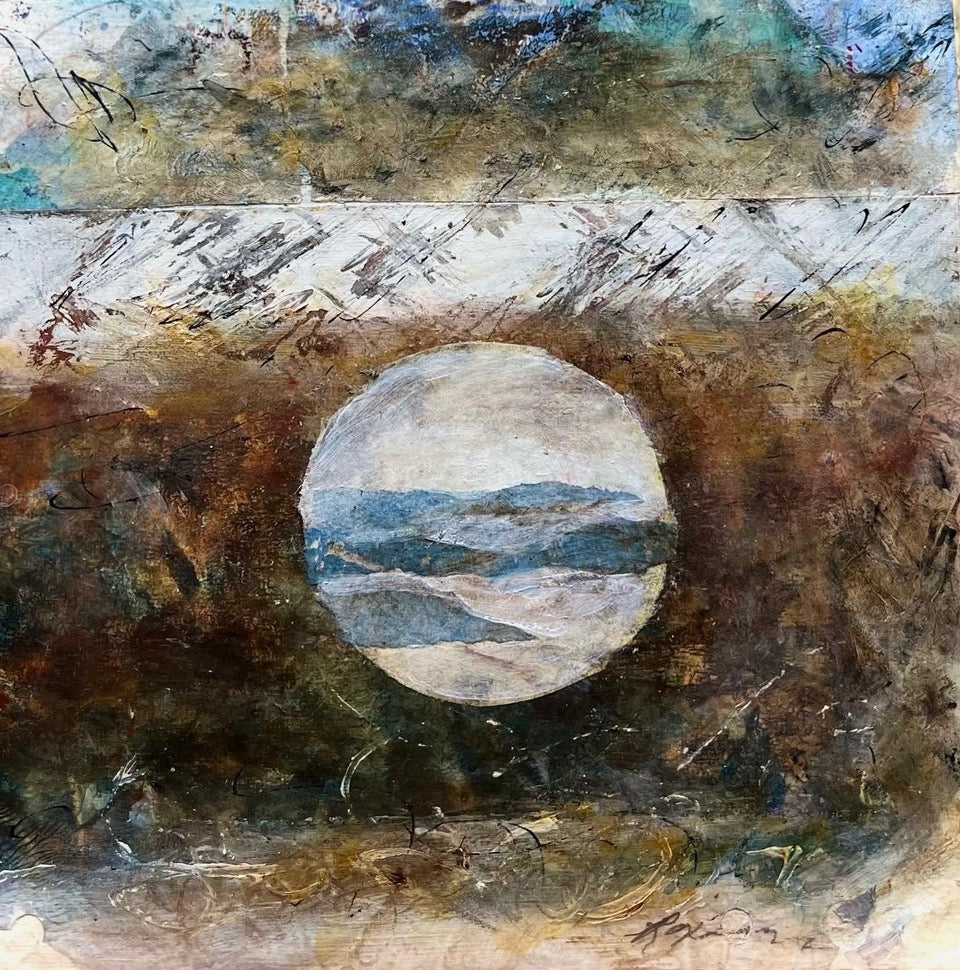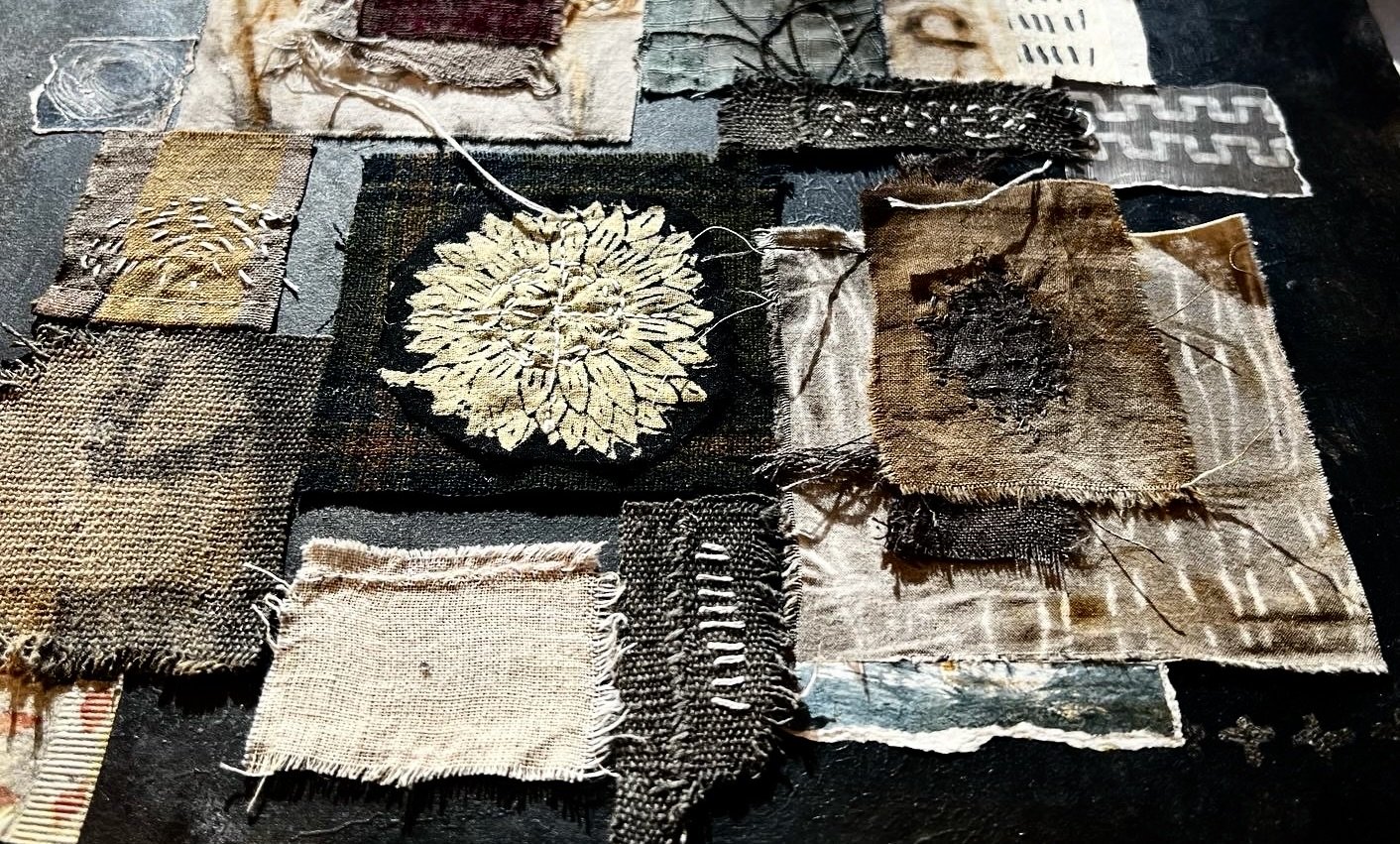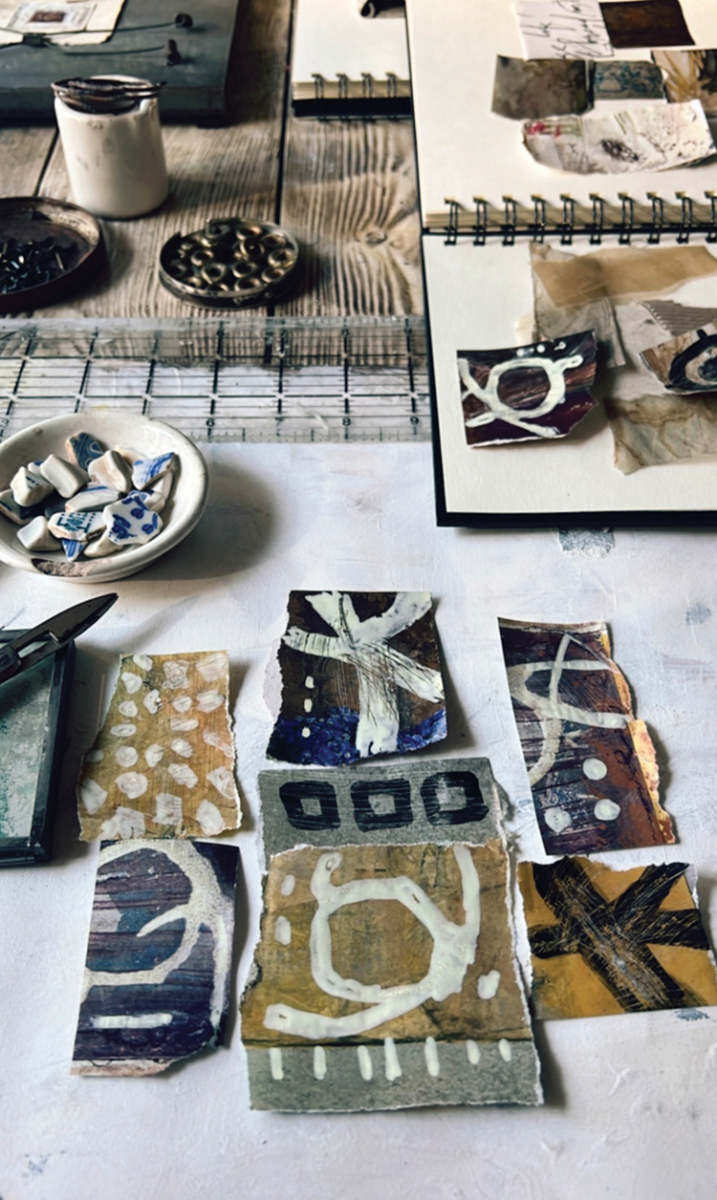A Conversation with Mixed Media Artist Roxanne Evans Stout

Roxanne Evans Stout, a mixed media artist, shares her artistic journey, her teaching experiences, and her creative process, which includes a love for nature and symbols. Aspiring artists are advised to explore and experiment. With an emphasized value of mindfulness in her teaching method, we're thrilled to be hosting Roxanne October of 2024 for a workshop on the Homestead.
This unique retreat combines art practice, self-expression, and living with nature. The retreat includes daily meals, art-skills workshops, and rustic luxury accommodations.
This interview has been edited for content. Watch the full video on Instagram.
Hunter Moon Homestead: So nice to see you, Roxanne in your beautiful studio. Where in the world are you joining us from?
Roxanne: I'm in Kino, Oregon and it's a really cold day. It even snowed a little bit.
We're very excited to have you [next October]! Could share a little bit about your art background and how you came to be an artist? Have you always been a creative? What did that journey looked like for you?
Yes, I have always been creative from when I was a little girl. I would be drawing and painting by the coffee table or on the dining room table, out on the grass, or on my bed. I been creating for a long time. My mom was an artist so she really encouraged me in that area. She got me enrolled in special art classes in a college that was a University Extension of UCLA down in Southern California.
I had lots of experience, and [exposure to] many different types of art. But it was basically drawing and painting. At first watercolors, and then acrylics and a little bit of oils.
It was about 10 years ago that I started doing more collage and the book arts, which I just love. I love the freedom of being a mixed media artist. There aren't rules, you know? [In paper arts] if someone does give you rules, you can break them. Different than watercolor painting because they have definite rules or you ruin it. My major was art and science and then I got credentials and started teaching art to middle school and high school, and I even taught in college for a while.
[Recently] I thought "I wanna teach adults. I wanna go to places, and experience groups that are my peers and get inspired by my students."
They say that in order to learn something yourself, it's important to teach it. So I'm sure you do take away as much as your students do.
Yes, I tell my students, "You're teaching me." It's just wonderful, especially when you have students that give you a little feedback or share their excitement about their projects. Something that's so lovely about being in a group setting with people is you get to engage in that creative process in a new way every time.
There's a chemistry within those workshop groups. It's so fun, even within our workshops, to see how different the work is that comes out of it based on that understand. Often times deep friendships come out of them as well. It's amazing. It's a beautiful experience, gathering in a workshop.There's nothing like it.
I'd love to hear a little bit more specifically about the work that you're doing now. We like to describe your work to people as earthy and very powerful. What words do you use to describe your work?
That's so beautiful that you say that and that's a wonderful thing to, to think that my work could be powerful. They say that the most inspiring art or the most compelling art is that art that's done from your heart. I feel like when you do art from your heart, that is the work that's gonna be your best work.

When you make art to sell, it doesn't have that special spark or feel. I try to do art for myself, and then later on after I'm done, I decide if I want to give it away or sell it. So, I would describe my work as "Art that is from my heart." It's also very tactile and textured. Some people say they feel a sense of longing or timelessness in my work.
I love symbols and the symbols really show themselves in my travels. I'm always finding symbols on the side of buildings, especially the old ones.
I feel like texture plays into that as well. I love that you said symbols because I can see that in your work. There really is a language. It is a way of storytelling.
I'd love to know how you encourage people to find their own story and tell it through their work? If someone's struggling to know what they want to say or how they want to say it, how is that part of your practice?
I really try to encourage my students to get a feel of the whole environment where we are. A feel of the land and the sounds and the sights. That feeling of wonder goes into their work and helps them find their own voice. To find your own voice is sometimes hard, especially when you're first learning. Some people find it naturally, but you don't have to necessarily find it right away because you're gonna be experimenting with all different colors, all different designs, all different media. Bit by bit certain colors will be "you," and certain certain shapes and marks. You're [slowly] creating your art. They'll all start to come together and be part of your own voice.
It's like developing that voice is what we do as artists, right? Going in, it can be intimidating because you feel like you have to know what your voice is, but it's in the process of creating that it evolves.
Sounds like there's a real mindfulness in your teaching process. Can you describe why you teach mindfulness as part of the process? Is it part of the discovery?
Oh, for sure, they're so connected.
The mindfulness is like, again being aware of where they are on the land, and the environment, and to feel grounded. Where do they feel grounded? I don't know if this is the same thing, but where are they are filled with wonder?
The wonder is like their curiosity, and their way of looking at the world, and just all the smells and the sights and the sounds they see it all comes together.
Kind of a meditation.
Yeah. I like start out on my work table. I always have straps of collage bits and fabrics and textured papers and mark making all over my table. And I kind of come in and start moving them around and that's kind of the beginning of my process of starting a project. Is that tactical feeling - that making a puzzle and changing it around, and moving things around, is a meditation. Kind of a sculptural process. It's wonderful.

How did you come to collage as a medium?
I had the opportunity to teach in a middle school and I got to order all my own supplies and create my own agenda and curriculum, and buy books. I started to get inspired by collage artists and then I started blogging around the same time. I met some friends and we did collage together. We started [making] artist books, where all the pages were collage, and oh boy, I was in love.
I just love making collages. I used to be a very tight drawer and I've gotten looser. I've tried and I've learned, and I'm still learning, to be a looser illustrator or sketcher. So I started collage, and it was just so relaxing and so much fun and playful. I've loved it ever since then.
How did you start incorporating fiber arts and getting into textiles?
I would say like about four years ago I started using fiber arts too. I love fabrics! I love kind of glazing them and painting them and, if I need to, staining them or printing on them really lightly so you can still see the texture. Vintage fabrics are the best. They're torn a little or [have some character]. They're wonderful.
Comes back to telling a story again. Those old fabrics have some history to it.
Do you get to do quite a bit of traveling to work? How did you come to that as part of your process? And what are some of your favorite places you've travelled?
I retired early from teaching public school, and I started doing my art full time. Then I started to teach workshops pretty locally, like on the coast here in Oregon. And then bit by bit I would branch out to across the state or across the United States.
And then people started asking me if I would come to their country. So now I get invited to go to all these cool places. I [prefer] the small villages and a natural environment. Those are the places that I say 'yes' to because if I have a feeling that that I can become part of that culture, then I know my students will too.
It just kind of happens. But for those of you who wanna teach, I would call or go in and introduce myself or volunteer to teach your workshop in their space. My very first workshop just had a couple of people in them.
That's a good way to learn though, right? Less pressure.
I'll never forget it. It was so great and a more intimate experience. There were just a few people there in the room.
I love that you mentioned that you like smaller towns that are surrounded by nature because that's definitely what we offer at Hunter Moon Homestead!
Yeah. It's a beautiful, beautiful countryside and the hills and the trees and the water, and it just looks like such a perfect place.

There's lots of nature [here] to be inspired by. I love how you incorporate nature into your work as well. Have you always been in nature and part of nature? And what, how is that symbolic for you in the work?
I've always wished I was in nature. I grew up in the city, in an apartment. It was a nice apartment. It had a big grassy area out front. My parents would take us out for drives and for little day trips or weekend trips up to the Sequoia or the Sierras or to the coast. Whenever I was out in nature I was in heaven. We'd drive by something and I wouldn't want to be [in the car], I'd wanna be out on that. On those rocks in the middle of the stream, you know, like that's where I would go. I've just always wanted to be part of nature, like it wants to be part of you too.
That's part of the human experience.
Yeah, I love it.
Can you tell us a little more about what you'll be teaching when you come out to the homestead?
We're going to, be working on making a fabric book, paper and fabric. I'll bring most of the base fabrics - linen and canvas. We're gonna do some collage on it and some mark making and some stitching. Our book structure, it could also be a wall hanging.
I love the palette you choose, to keeping it really neutral.
I like really neutral in my colors. But, a lot of my students don't and that's ok. I want them to be who they are. So that's what we're gonna be doing. We'll kind of take some time to go gathering. We'll take time to make maybe a small assemblage or two, and create and out of a chunk of wood or stones or we'll find something beautiful to do outside too.

I can't wait to have you with us. For those that are interested, Roxanne will be teaching her workshop at Hunter Moon Homestead the first weekend in October. We offer all inclusive workshops. So you'll get to stay with us on site. We feed you three meals a day out of the garden. Really gorgeous food. It's a really special experience, not only to learn how to do art, but how to become closer to your own creative self.
You don't have to be an artist to come. I think that's really important to share with people. People think. "Oh, I'm not creative. I can't make art," but it's really important to cultivate that creator part of yourself.
Thank you, Roxanne, for sharing a little bit about yourself today. It's been so much fun to talk to you.
Thank you. It was so much fun to talk to you too.



